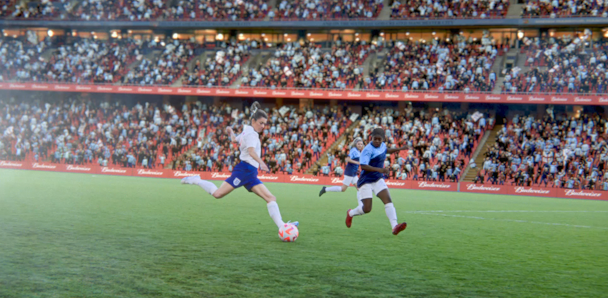Despite tricky timings for many viewers, brands shouldn’t sleep on the Women’s World Cup
With awkward kick-off times potentially dampening viewer enthusiasm for the Fifa Women’s World Cup in some core football markets, how can advertisers effectively support the tournament in other ways?

Budweiser has gone big on the Women's World Cup but other brands have been more circumspect / Budweiser
It might be us, but we've seen fewer Fifa Women’s World Cup activations than we would’ve expected (though we are keeping track of the best efforts we do see). Other than Wimbledon, it’s the big sporting moment of the summer. But because the tournament is in Australia and New Zealand and kick-off times will be earlier than typical for US and European fans, the lack of prime-time action may be a factor.
In turn, that might limit engagement with sponsor activations around the competition. So, we asked a top team of agency experts how they’d advise clients to dribble around that obstacle and make a success of their World Cup activation.
How do you solve a problem like... activating around key cultural moments when viewer attention isn't guaranteed?
Misha Sher, global head of sport, EssenceMediacom: “When we look at how sports consumption has evolved, it’s clear that live viewership is only one component. Content in and around major events has become as important as the live events themselves, giving brands far greater flexibility in how they show up. Rather than looking at time difference as a barrier, brands should look at this as an opportunity to demonstrate their utility and relevance in one of the fastest-growing sports in the world. We all know that building brand equity takes time and a sustained commitment, so my advice is to look at this moment as part of a long-term investment that is guaranteed to deliver over time.”
Advertisement
Helen Brain, comms strategy director, Iris: “Bearing in mind the 17 million plus viewing figure of the Uefa Women's Euro 2022 final, viewer attention is there for the taking – we just need to get the comms strategy right. While live viewing may be tricky, there is an opportunity for brands to support women by increasing coverage in other ways. Brands can add value by bringing match content into spaces where fan communities mix. Think highlight roundups in social feeds, real-time viewing parties via partnerships, or social filters that let fans ‘wear’ the England shirt - all of which would pull attention from a Lioness-loving UK. As an under-supported and under-activated space, the brands who do invest in it could win more than their fair share of attention.”
Josh Green, executive creative director at House 337 Sport: “The time difference might not be ideal for beer activations, but pre-noon kick-off times could be perfect for reaching young families – an audience which is already more open to watching women’s sport. So rather than presenting a significant barrier, this World Cup is actually a huge opportunity for brands which are interested in actively engaging family audiences around emotional, shared sporting moments, with the added plus of supporting a rapidly growing game.”

Basia Wojcik, vice-president of sports, TMA: “Time zones are often a challenge with viewership for global events, like World Cup and the Olympic Games. The days when a TV audience could deliver a sufficient ROI by itself are long gone! The opportunity lies in the partnership overall, the ability to use the IP/marks of those global entities to make the emotional connection and create cultural resonance. These global partnerships are significant investments. To fully capitalize on those, brands must be prepared to activate meaningfully across multiple channels. You can also consider other partnership tiers and build campaigns focused on a particular team or specific athletes, depending on your objectives and budget.”
Advertisement
Charlie Brown, head of sport and entertainment, The Romans: “Think tactically about how you can get the best out of activating, even when viewers’ attention isn’t guaranteed. We’ve seen from various research reports that women’s sports fans are way more inclined to build brand love & loyalty with brands that show their support for the women’s game. So maybe this is your opportunity to continue to build loyalty among fans, those fans that will see your activation. Not only fans, but talent. Building those relationships with players, rights holders and teams can be just as important. Think longer term, looking ahead to Euro 2025 in Switzerland, viewer attention will be more guaranteed and by supporting the game now, it could lead you to be at the front of the queue later down the line.”
Danny Gilchrist, brand director, ScienceMagic: “When we think about communities - the spaces and moments that they live in – the priority for our clients and talent is not solely to gain attention, but to enable support and mutual value for the community around its cultural moment. The mistake is assuming you need to involve your brand in multiple moments because of the scale of the opportunity. At ScienceMagic, we push ourselves to understand if the value of an investment in a particular moment delivers for the community first, alongside the brand participating. Will this add something impactful, meaningful and culturally worthy for the community, the brand, and the talent? The answer must be a convincing ‘yes.’”
Ashley Brantman, senior vice-president partnerships and co-head of Jack Morton sponsorship consulting practice Jack 39: “For brands to activate around a key cultural moment, they need to identify a common purpose and/or passion that resonates with the audience they want to talk to and influence. With the Women’s World Cup there are many rallying points from love for the game to patriotism and being an ally for female athletes. Even if linear viewership isn’t anticipated to be high, that doesn’t preclude a brand from making an impact against some of their objectives by capitalizing on the intersection between passion and purpose.”
Suggested newsletters for you
Louisa O’Connor, managing director, Seen Presents: “The key is to tap into the viewers’ cultural and emotional drivers. How are they most likely to consume the content – on catch-up, live, via forums, chat rooms, social media? Consuming entertainment is now much more than just sitting down and watching it as it happens – Twitch, TikTok and YouTube allow entertainment to travel further and be accessed by more. So tap into those ways to communicate with your audience as those channels operate 24/7 and are more likely to get engagement.”
Nick Andrew, managing partner at AMV BBDO: “The answer to a problem like “viewer attention isn’t guaranteed” is to force yourself to do something surprising and subversive. And that often makes them the most exciting briefs to work on. You have to generate a new cultural conversation. Rather than insert yourself into an existing one. As Bill Bernbach said, people “won’t listen to you if you’re not interesting – and you won’t be interesting unless you say things imaginatively, originally and freshly.” Perhaps the best example of this spirit was Channel 4s work on the 2012 Paralympics (or any of their Paralympics work for that matter), which catapulted the Games into the spotlight like little work has done before or since”.
Jacquie Kostuk, director of creative strategy at Fuse Create: “Prepare for real-time reactions - what matters at an event is what happens, so reasonably predict, and be ready to adjust so you can push live rapidly. And hold resources back to activate the highlights, lowlights, and meme-able moments that are still trending post-time difference. To do so, you’ll need a few choose-your-own-adventure plans that can be tailored to actual events. This includes developing a base of assets that can be altered quickly so you don’t miss out on what’s actually captivating your target if the event itself isn’t.”
Francis Dumais, managing partner at Elevant: “Viewer attention is never guaranteed. Fans consume content differently, and global brands adopt targeted approaches to activations. Markets tailor strategies to local objectives from global rights. Big advertisers aim to ‘own’ a category, maintaining a constant presence with engaging content. They utilize multiple layers, such as partnerships with teams, leagues, players, and events, rather than relying solely on a key cultural moment. F1 and Tour de France exemplify this through their Netflix series, which are captivating audiences despite their events occurring a year ago. This offers great new additional visibility for brand sponsors.”
Sandy Ramos Zohios, product marketing lead, My Code: ”Although timing and location for this year’s Women’s World Cup are less than ideal for key consumers and viewership, this should not be seen as a setback for brands to activate around the tournament. This year’s Women’s World Cup is projected to break records with over a million tickets already sold. The tournament will only continue to gain more traction and momentum as it progresses – creating more opportunities for sponsors to be involved after it’s begun. Brands should consider leveraging digital platforms, social media, and influencers to generate buzz and maximize audience attention. In addition, sponsors should consider post-tournament opportunities beyond the tournament itself to develop a long-term commitment to women’s soccer.”
Cos Mingides, founding partner, True: ”It is often said that you have to ‘earn’ attention through emotional creative - which is absolutely true - but recent research from Karen Nelson-Field has shown that media selection should dominate the attention conversation. The same creative on low attention media does not perform equally. Focusing on channels with less attention decay, such as TV and online video, can increase viewer engagement with your creative by up to 75%. And if you can create relevance around the specific cultural or sporting event that taps into prevailing emotions – the highs and lows, you’re onto a winner.”
James Kirkham, chief executive officer at Iconic: “I believe brands are more forward thinking and will still deliver. Few are so myopic that they’d refrain from activating around the World Cup solely because of kick-off times; it is not the 1980s, after all. Football leads other sports to in being consumed through clips, memes and fan-centric content way beyond the 90-minute product. The success of content such as Budweiser’s ‘Agree to Disagree’ during the World Cup in Qatar demonstrates that it is more important to focus on the personalities of players and content which can live irrespective of game time, which succeeds for brand and audience alike. I think we’ll still see a raft of quality activations through the tournament, but just away from the more traditional hype windows.”
Alex Beazley-Long, senior strategist, Imagination: “Sponsorship is about more than just attention. The number of eyeballs is only part of the equation when deciding which sporting or cultural events to support. Smaller or more niche cultural moments allow brands more ownership, attribution, and ultimately creativity. Brands should own the fact that attention isn’t guaranteed and shine a spotlight on sports and individuals that deserve more attention from the wider public. With fewer official sponsors and brand noise, there is the opportunity for more involved and integrated activity, utilizing top talent.”
Want to join in future conversations? Email me at sam.bradley@thedrum.com.

